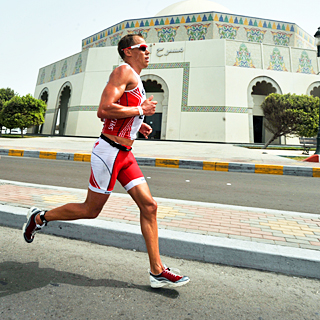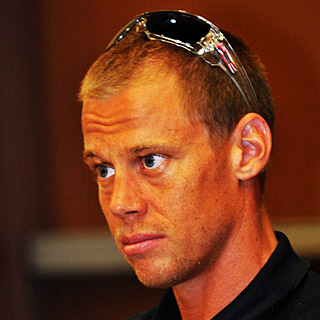Rasmus Henning’s Revival
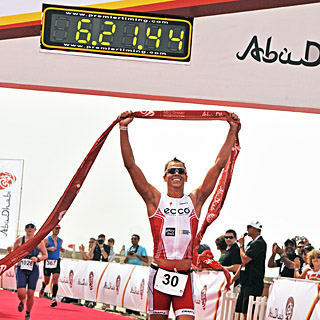
Coming off his $200,000 wins at the Hy-Vee World Cups in 2007 and 2008, his five World Cup wins, 7th and 8th place finishes at the 2004 and 2008 Olympics, his silver medal at the 2001 ITU Long Distance World Championship, Rasmus Henning looked like a great bet to become one of the premier contenders fighting for the win at Kona.
Once he switched to long course in 2009, he won Ironman China, then took an impressive 5th in his Kona debut despite racing with a broken hand suffered three weeks before the race. In 2010, he seemed right on track for a Kona podium after posting the 5th fastest Ironman distance time ever with a 7:52:36 winning effort at Challenge Roth in 2010.
But after that, Henning fell short of his own high expectations. At Kona in 2010, he got bruised in the ribs on the swim start, fell off the pace on the bike, and finished with a dispirited 3:05:40 marathon for a 23rd place finish. In 2011, he was further discouraged when hit by paralyzing legs cramps at Abu Dhabi, which set him off on a roller coaster down-and-occasionally up cycle – seconds at 70.3s in Oceanside and Galveston and a win at Timberman 70.3, a second super cramp episode at Aarhus and most dispiriting – a second straight bust at Kona with a 14th place finish.
While 2011 was a nice season for almost anyone else, by Rasmus Henning’s high standards it was a debacle that fomented thoughts of retirement at age 36 or admitting defeat and forsaking his Kona dreams.
Which is why Henning's world class win at the Abu Dhabi International Triathlon last weekend was a momentous game changer and massive confidence booster for triathlon’s Prince of Denmark.
Slowtwitch: How did you fight off the cramping that had been bedeviling you for the last 18 months and win such a big race today?
Rasmus Henning: By making the most of my potential. By staying with the top chase group and not trying to do anything stupid out there on the bike. After I finished riding, I thought if I can go out and run against these guys I might have a shot at the podium. And it finally it turned out it was enough for the win.
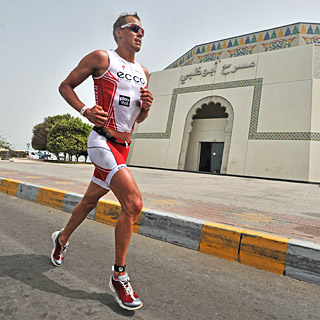
ST: Did the fact that the lead group of cyclists weren’t working as effectively as possible play into your hands?
Rasmus: If they [the leading bike group] didn’t work too well together, we [the chase group] didn’t work too well together either. Andi Bocherer did a great, great job out on the course with our group. That meant a lot to me and the fact that he could back it up by getting 4th today is really amazing. The rest of us took some turns in front. But there was no true cooperation. Half of our group was just sitting behind the whole time. So if they didn’t work well together in front then we didn’t either. Which makes it even out.
ST: Where does this win rank with your two Hy-Vee victories and winning Roth in 2010 with the 5th-fastest ever 7:52?
Rasmus: This win is right up there with Roth and with Hy-Vee and winning the European champs several years ago. This is actually quite emotional for me. Because it’s been really rough for me since I did the 7:52:36 [the 5th fastest men’s Ironman distance time in history] at Roth in July 2010. That obviously raised a lot of expectations I had for myself.
ST: You had some ominously bad days mixed in with very decent performances by anyone else’s standards. Worst would be your cramps meltdowns in Abu Dhabi in March 2011 and at the Aarhus half in September. Very decent performances would be your close second place finishes at 70.3s at Oceanside and Galveston. Very disappointing would be your 23rd at Kona in 2010 and your 14th in 2011 at Kona. What was going wrong and how stressful was it?
Rasmus: I’ve just been suffering so much from cramps – cramps that were nor regular cramps but ones that felt like they were tearing my leg apart. Cramps that were so painful – and when I got off the bike my knee was locked for hours before it would release after the race. I had those severe cramps in Abu Dhabi and then in a later race in Aarhus as well. You can read a lot about it in my book which is coming out soon. [”Udfordringen (The Challenge),”] That was a big setback which was very tough on me. And during this period, in every other race I had regular cramps which were always preventing me from really pushing it to the end. I had the energy but my muscles were just going away from me.
ST: What did you do to solve this problem? And how frustrating was it to not find a solution for nearly two years?
Rasmus: I worked on it especially with my new coach Matt Dixon. To find out what we could do, how we could deal with dehydration and the replacing electrolytes and everything — leading up to the race and during the race. Obviously today it worked.
ST: Were you haunted the last 10k of this run that the cramps might strike again?
Rasmus: Of course it did cross my mind whenever I felt the slightest hint of a cramp. But throughout the day I felt so good I thought I could keep a strong pace.
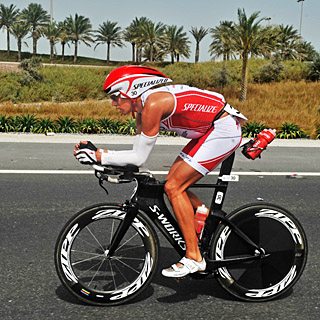
ST: How long had it been since you felt anywhere near your best throughout a race?
Rasmus: I hadn’t put a proper race together since I did that 7:52 at Roth in the summer of 2010. [with a 2:39 marathon]. Just the fact that I finish strong today was a major step for me. I did my nutrition perfectly. I conserved energy on the bike as far as I possibly could. It wasn't until the last 50k or 60k of the bike that I started to take some responsibility to keep the pace up. Because I could see the guys out front were 4 minutes ahead, it was getting slightly dangerous. But I wasn't thinking too much about the win. I was more thinking how to get that race without the cramps. And then, I wanted to see if I could maybe get on the podium if I had a good day to the end. On the run, I felt that I was flying like I haven’t in a very long time. And it was just enough to catch Faris.
ST: You said you were worried Faris was too far ahead as you started the run?
Rasmus: When I started running, I thought four minutes down to Faris was probably too much. But then I could see on the time splits it was possible and if we kept the same difference in pace I might be able to catch him.
ST: At what point did you truly envision it was possible to win?
Rasmus: It wasn't until the final turn out by the flagpole [about 15 kilometers into the 20k run] where I could see he was within 30 seconds and I could almost grab onto him and could reel him in. So I used that mindset. I caught him and stayed with him a while and then dropped him.
ST: How is it you beat the race record by 10 minutes?
Rasmus: It was good conditions for sure. It wasn't hot. The heat didn’t really play a big role. I am sure some age groupers will say it was windy out there. I didn’t get on the bike last year so I could not say for sure. But I think the winds were much better this year. I live and train in the Canary Islands where it is always much, much windier than this. So it wasn't really windy.
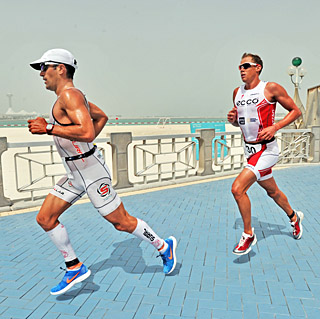
ST: What did you do with Matt Dixon and your nutrition to eliminate those terrible cramps?
Rasmus: I could tell you but I would have to kill you. CHUCKLES We worked a lot on working out what kind of electrolytes and also the kind of rest I got for my calves in the days leading up to the race. And also during the race we tried to make sure I got the right nutrition in the right amounts. Also I was playing it very, very cautious on the bike. Not trying to attack early on the bike, just conserving energy. Towards the end of the bike, I was allowed to push hard and go out of my comfort zone if it was needed. But I pretty much stayed within and managed to conserve it for the run. Then I could let it all out.
ST: How big a relief was it to race like the old Rasmus again after year and a half of frustrating?
Rasmus: It was so much of a relief. On my bad days I saw myself being over and done as a triathlete. This just proves I still have the level to compete with the best and it’s gonna mean a lot for this season to come. It is going to bring back that feeling that I want to go back and compete in Kona. To tell the truth I pretty much lost that hunger. I was considering never going back there again. Maybe now I can start building on that again, and I can actually go really well at Kona again.
ST: Who can you thank for this revival?
Rasmus: Thanks to Matt Dixon for making the effort to have me nail the nutrition and that cramping situation. He has been a great help.
And also to my wife Anita! She wrote an email to me last night that I read this morning. Just explaining that she really believed in me and she was sure that I could do it. That meant a great deal to me and I thought a lot about that out there today.


